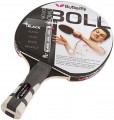Handle shape
— Straight. The simplest form, assumes a flat surface of the handle, without extensions/contractions. For some players, this shape may well be optimal, but in general,
straight handles are considered less comfortable than flared or anatomical ones. Therefore, although quite a lot of such rackets are produced, they are noticeably smaller than models with other types of handles, and they mainly belong to the initial class (1 *, 2 *), although there are rare exceptions.
— Flared. The handle of this shape expands noticeably towards the end. This makes the grip more comfortable and secure than the straight shape, while
flared handles are easier and cheaper to manufacture than anatomical ones. Due to this, this option is very popular today, it is used in most rackets of all classes.
—
Anatomical. This category includes handles, the shape of which is optimized for the shape of the human hand. Usually, they have characteristic notches, where the fingers of the athlete fall when held; this can improve the comfort of use and reduce fatigue. On the other hand, such handles are somewhat more complicated, and as a result, they are more expensive than straight or flared ones. In addition, they require increased attention when choosing: even a very small discrepancy between the profile of the handle and the size of the hand can cause inconvenience and reduce all the
...advantages of such a racket to zero. As a result, anatomical handles are somewhat less common than conical ones.
Note that the main selection criterion for the shape of the handle is solely the personal preferences of the athlete. There are no general rules about which option is “better” or “worse”: for different people, the optimal form often turns out to be different. Therefore, before buying, it is highly advisable to try the racket in your hand and evaluate the suitability of its handle for your own preferences.
Note that the same racket model can be produced in several modifications that differ in the shape of the handle; in such cases, the characteristics indicate all available options. And the bases (see "Product type") are, by definition, produced with different shapes of handles; therefore, for this type of product, this moment is not indicated at all.Speed
Table tennis rackets have 3 main practical characteristics: speed, spin and control. The general class of the product, the style of play (see above), the available techniques, the requirements for the player's skills, etc. depend on their values and ratio. One of the most popular designation options is on a hundred-point scale; This scale is also used in our catalogue.
The speed indicator describes how fast the ball will move after contact with the racket. High-speed values are very important for an attacking style of play.
Spin
Table tennis rackets have 3 main characteristics: speed, spin and control. The general class of the product, the style of play (see above), available techniques, requirements for player skills, etc. depend on their values and ratio. One of the most popular designation options is on a hundred-point scale; This scale is also used in our catalogue.
The higher the spin number, the more the ball will spin with the corresponding hit and the better the racket is suitable for various spinning techniques.
Control
Table tennis rackets have 3 main practical characteristics: speed, spin and control. The general class of the product, the style of play (see above), available techniques, requirements for player skills, etc. depend on their values and ratio. One of the most popular designation options is on a hundred-point scale; This scale is also used in our catalogue.
Control describes the overall handling of a racket. Roughly speaking, this is a parameter of how easily it can be used to give the tennis ball exactly the speed, direction of flight and rotation that the athlete wants to provide. High values on the control scale will be comfortable regardless of the level of the player and the style of play; however, increasing the speed/rotation hurts control, as a “faster” or “spinning” racket is usually more demanding on the accuracy of movements. Therefore, many models for professionals and experienced amateurs, usually, are distinguished by a low degree of controllability, and “beginner” rackets, on the contrary, have high control parameters and low speed/spin.
Number of base layers
The number of layers that make up the base of the racket. The number of layers affects the degree of rigidity and elasticity of the base and, accordingly, the characteristics of the rebound of the ball. However, this moment is irrelevant for the simple reason that the materials used (see above), the presence of inserts, build quality, sponge thickness (see below), etc. also affect the mentioned characteristics. And given that modern table tennis rackets are very diverse (for example, wooden models can use different types of wood), the number of layers is today a reference parameter, which in itself does not affect the practical characteristics of a particular model.
Sponge thickness
The sponge is the bottom layer of the coating, located under the outer coating (rubber is most often used for such a coating). The thickness of the sponge determines the characteristics of the impulse that the racket transmits to the ball, and, accordingly, the characteristics of the flight of the ball after the impact; in other words, this parameter affects all three practical characteristics of the racket - speed, rotation, control. Accordingly, models for different playing styles (see above) also differ in sponge thickness.
So, a small thickness - up to 1.5 mm - is typical for protective style products, which are distinguished by low speed and good control. All-purpose rackets use sponges of the thickness of 1.5 – 1.8 mm, which provides a balance between speed and control. And thick sponges - from 2 mm - are installed in rackets for an attacking game, and the greater the thickness, the higher the speed and rotation, and the worse the control.

